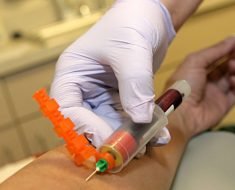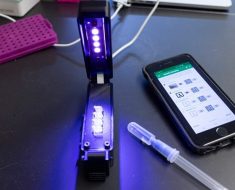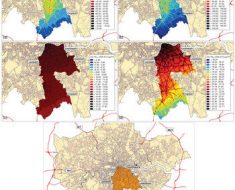By the time Debby, a 44-year-old insurance agent, walked into a a Stretch U assisted-stretching facility, she’d experienced 10 years of crippling back and neck pain. It was so bad that it often woke her in the middle of the night.
About three years ago, Debby began trying all types of treatments, including massages, chiropractic medicine, physical therapy, yoga, and prescription nerve-blockers. However, they offered only temporary relief. That’s when she decided to give assisted stretching a try. This is her story.
The problem: Unbearable neck and back pain
As an insurance agent, I sit all day at a desk. So it didn’t exactly surprise me that I eventually developed neck and back pain. But about two years ago, the pain went from a dull ache to burning, fiery stabbing, making it difficult for me to walk, sit, sleep, or do anything normally. I grew desperate for a solution.
The diagnosis: Degenerative disc disease
I started out with twice-weekly massages. I thought it would help release the tension in my muscles. But the relief it provided was short-lived. I’d feel great the rest of the day, but then the next morning, I’d wake up in pain again.
When I consulted my primary-care doctor, he recommended yoga and physical therapy. However, I was too stiff to hold any yoga poses, and during PT I was in so much pain that my blood pressure would spike, and my therapist would have to stop treating me.
My primary care doc then referred me to a pain-management specialist, who revealed the underlying cause of my pain: degenerative disc disease, which occurs when discs in the spine lose fluid or develop small tears or cracks. The condition is partially genetic (my mother has it, too), but I also learned that sitting for prolonged periods of time—like I do at my job—makes it worse.
Being diagnosed with degenerative disc disease felt like a death sentence. The doctor told me, “It’s not going to get better, only progressively worse, so all we can do now is manage your pain.” He suggested all kinds of strong medications—and I said no way. I was only 43 at the time, which just felt too young for me to accept this diagnosis and start popping pain pills. I did agree to one of his recommendations—a prescription nerve-blocker—and quickly regretted it. The drug made thinking clearly and problem-solving impossible, which affected my job performance.
A new approach
I ping-ponged from specialist to specialist seeking relief from my snowballing symptoms, including arm numbness, foot pain, and tightness in my Achilles tendons. After neither chiropractic care nor steroid injections relieved my pain for more than a week or two, my doctor recommended surgery.
That’s when I decided to try one more thing: assisted stretching. I’d driven past a facility called Stretch U a number of times on my way to my chiropractor’s office, so I asked my chiropractor about it and told him I was interested in booking an appointment. When he thought I was stable enough to give it a try, I met with Bren Smith, the owner of my local Stretch U to learn more.

What is assisted stretching?
With assisted stretching (also called facilitated stretching), a trained stretcher manually maneuvers limbs to lengthen and release a client’s muscles. Allowing someone else to do the work for you can give you a deeper stretch, according to Stretch U founder and physical therapist John Carey. In the same way that you’d work with a personal trainer to build strength, you work with a stretcher to build flexibility.
The turning point
At my first weekly assisted stretching appointment, I told Bren that I wanted to be flexible enough to do yoga without being in pain. If I could just hold the poses, I knew that yoga would help with my posture and core strength, which my chiropractor said could reduce my back pain as well. Bren explained that Stretch U’s assisted stretching program would give me the extra push I needed to achieve the flexibility that yoga requires.
My first few appointments, I was really gritting my teeth and laboring through it. I would take deep breaths as though I was in a Lamaze class. The IT band stretch was the worst part; Bren would take my leg and try to pull it across the other one, and it would barely budge.
Within a few weeks, though, the stretching sessions got easier—and gradually, my pain began melting away. I could finally bend over or sit for a couple of hours without feeling the tightness and pain in my back that I’d experienced for so long.
After a couple of months, I slept through the whole night without waking up in pain—and it was simply the greatest feeling. When you deal with chronic pain, your mind tends to numb itself to it so you can get through your days, so I think it took me a few days to realize exactly what was happening. But as the pain decreased and I got more sleep, my mood improved, and I became a more fun person to be around.
Over time, that tough IT-band stretch got easier, and a few months ago—about nine months after my first Stretch U session—one of the trainers told me that he was trying to be creative with my stretches because I’d gotten so flexible!
These days, I go less often, usually once or twice a month, just to maintain the progress I’ve made.

The relief
The biggest wow moment for me came a few months ago. I realized I could sit at my desk and work on the computer for hours without any sort of stabbing or burning pain in my neck. Soon after, even my co-workers acknowledged my brighter mood and the fact that I didn’t look like I was in constant pain.
Now, on an average day, I don’t experience much discomfort. If anything, I’ll feel a twinge only after I’m on my feet for a while, like when I’m singing with my band. But overall, I feel much better. I used to be such a boring performer because it was hard for me to dance and move around the stage, but now I can do both of those things with ease.
Of course, I’m not completely healed. I still have degenerative disc disease, which is a difficult fact for me to swallow. But stretching gives me relief unlike anything else I’ve tried. I’m more convinced now than ever that it’s essential for overall health—particularly for those who work desk jobs like mine.
Looking for a stretch studio near you? Try Stretch Studio in Sydney and Melbourne, Brisbane Stretch Therapy, Better Movement Studio in Adelaide and Movement Co in Perth.
This article originally appeared on Prevention
Source: Read Full Article





